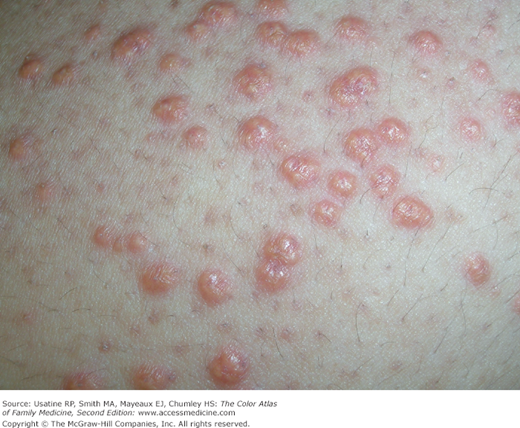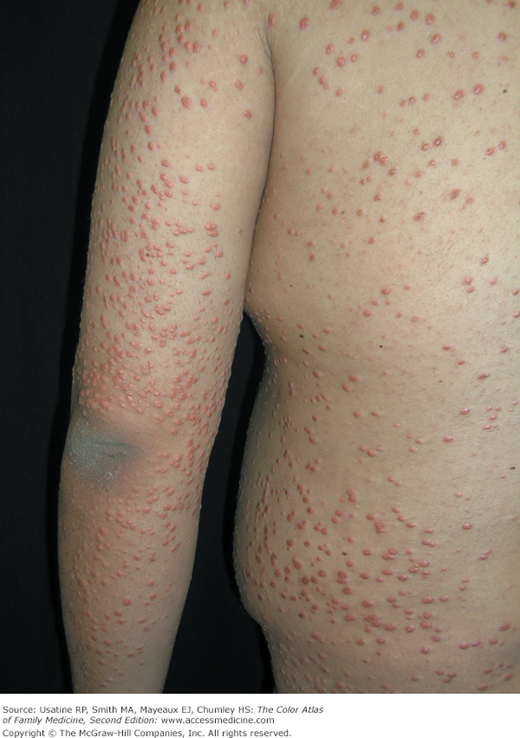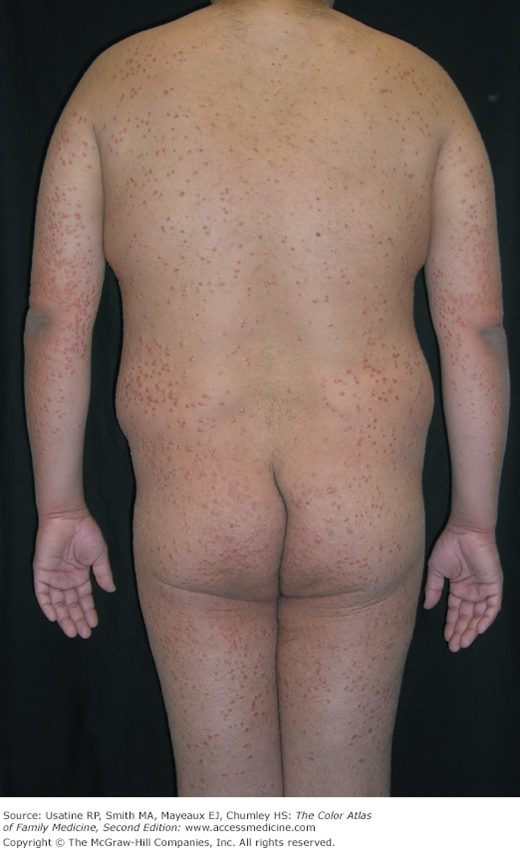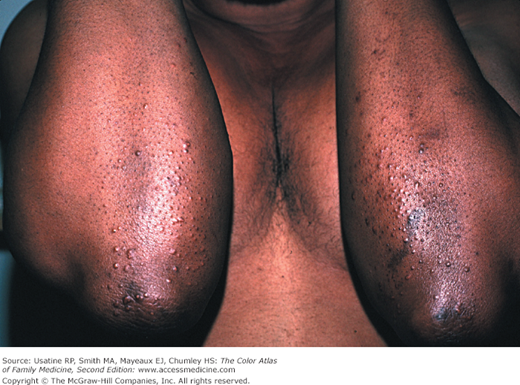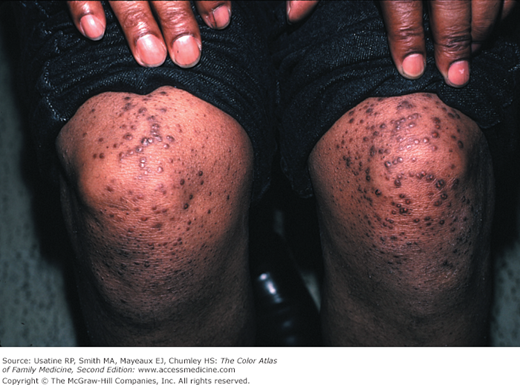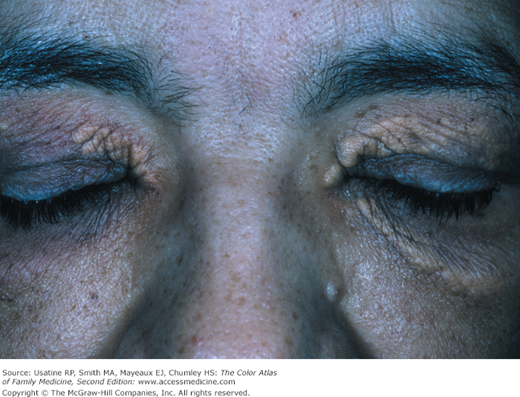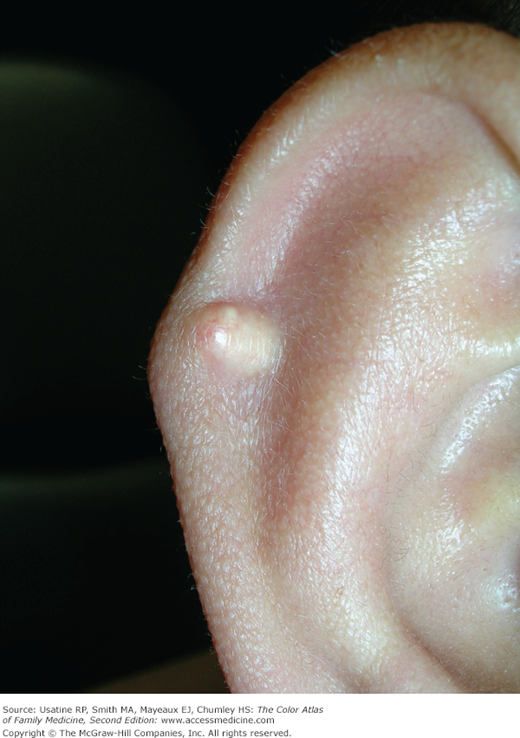Patient Story
A 27-year-old Hispanic man reported new painful nonpruritic bumps, which started 6 months ago, over his entire body. The patient had not seen a physician for 10 months and had run out of his oral medicines for type 2 diabetes mellitus. His grandmother had a milder version of bumps like this years ago. The firm yellowish papules were present all over his body from the neck down (Figures 223-1, 223-2, and 223-3). Laboratory evaluation revealed a random blood sugar of 203, a fasting triglyceride level greater than 7000 mg/dL, and total cholesterol greater than 700 mg/dL. High-density lipoproteins were 32 mg/dL, and there were no chylomicrons present. The patient was diagnosed with xanthomas, poorly controlled diabetes mellitus, and hyperlipidemia, and was started on metformin, gemfibrozil, and a β-hydroxy-β-methylglutaryl-coenzyme A (HMG-CoA)-reductase inhibitor.
Figure 223-1
Close-up of eruptive xanthomas on the arm of a 27-year-old man with untreated hyperlipidemia and diabetes.1 (Courtesy of Richard P. Usatine, MD.)
Figure 223-2
Eruptive xanthomas on the arm and trunk of the man in Figure 223-1. (Courtesy of Richard P. Usatine, MD.)
Figure 223-3
Eruptive xanthomas covering most of the body of the man in Figure 223-1. (Courtesy of Richard P. Usatine, MD.)
Introduction
Hyperlipidemia refers to an elevated concentration of one or more of the measured serum lipid components (total cholesterol [TC], low-density lipid [LDL], high-density lipoprotein [HDL], and triglycerides [TGs]). Xanthomas are a skin manifestation of familial or severe secondary hyperlipidemia, although they can occur in patients with normal lipid levels. Hyperlipidemia is a major modifiable risk factor for cardiovascular disease.
Epidemiology
- During 2005 to 2006, 15.7% of adults in the United States had a high serum TC level.1 The average cholesterol level of adults ages 20 to 74 years decreased from 222 mg/dL in 1959 to 1962 to 197 mg/dL in 2007 to 2008, reaching the Healthy People 2010 goal.2
- An estimated 34% of the adult population had high LDL-C during 2005 to 2008 (LDL-C levels above the recommended goal levels or reported current use of cholesterol-lowering medication).3
- Among young adults (ages 12 to 19 years), 20.3% had abnormal lipids; boys are more likely than girls to have at least 1 lipid abnormality (24.3% vs. 15.9%, respectively).4
- Patients with homozygous familial hypercholesterolemia (FH) (1 in 1 million persons worldwide) present in childhood with cutaneous xanthomas on the hands, wrists, elbows, knees, heels, or buttocks.5
- Patients with heterozygous FH (1 in 500 persons worldwide) can present as adults with tendon xanthomas.
Etiology and Pathophysiology
- Lipoproteins are complexes of lipids and proteins essential for transporting cholesterol, TGs, and fat-soluble vitamins.
- Elevated levels can result from genetically based derangement of lipid metabolism and/or transport or from secondary causes such as diet, medical disorders (e.g., type 2 diabetes mellitus [DM], hypothyroidism, chronic kidney disease, cholestatic liver disease), cigarette smoking, obesity, or drugs (e.g., corticosteroids, estrogens, retinoids, high-dose β-blockers).
- Increased circulating LDL becomes incorporation into atherosclerotic plaques. These plaques can grow to block blood supply and oxygen delivery resulting in ischemia to vital organs. In addition, if the plaque ruptures, it can precipitate a clot, causing for example myocardial infarction.
- Elevated TG is an independent risk factor for coronary heart disease (CHD) and increases the risk of hepatomegaly, splenomegaly, hepatic steatosis, and pancreatitis. Contributing factors include obesity, physical inactivity, cigarette smoking, excess alcohol intake, medical diseases (e.g., type 2 DM, chronic renal failure, nephrotic syndrome), drugs (as above), and genetic disorders (e.g., familial combined hyperlipidemia).6
- Xanthomas are deposits of lipid in the skin or subcutaneous tissue, usually occurring as a consequence of primary or secondary hyperlipidemia. Xanthomas can also be seen in association with monoclonal gammopathy.7 There are five basic types of xanthomas:
- Eruptive xanthomas (also called tuberoeruptive) are the most common form. These appear as crops of yellow or hyperpigmented papules with erythematous halos in white persons (Figures 223-1, 223-2, and 223-3), appearing hyperpigmented in black persons (Figures 223-4 and 223-5).
- Tendon xanthomas are frequently seen on the Achilles and extensor finger tendons.
- Plane xanthomas are flat and commonly seen on the palmar creases, face, upper trunk, and on scars.
- Tuberous xanthomas are found most frequently on the hand or over large joints.
- Xanthelasma are yellow papules found on the eyelids (Figure 223-6). Fifty percent of individuals with xanthelasmas have normal lipid profiles.
- Eruptive xanthomas (also called tuberoeruptive) are the most common form. These appear as crops of yellow or hyperpigmented papules with erythematous halos in white persons (Figures 223-1, 223-2, and 223-3), appearing hyperpigmented in black persons (Figures 223-4 and 223-5).
Figure 223-4
Eruptive xanthomas on the elbows of a hyperlipidemic black man with type 2 diabetes. His triglycerides and total cholesterol levels were high.1 (Courtesy of Richard P. Usatine, MD. Previously published in the Western Journal of Medicine.)
Figure 223-5
Eruptive xanthomas on the knees in the patient in Figure 223-4. (Courtesy of Richard P. Usatine, MD. Previously published in the Western Journal of Medicine.)
Risk Factors
Diagnosis
- Most patients with hyperlipidemia are asymptomatic.
- A very high TC level (>2000 mg/dL) may result in eruptive xanthomas or lipemia retinalis (white appearance of the retina; also seen with isolated high TG). Very high LDL may lead to the formation of tendinous xanthomas.
- Xanthomas manifest clinically as yellowish papules, nodules, or tumors (Figure 223-1).
- Eruptive xanthomas (Figures 223-2, 223-3, 223-4, and 223-5) begin as clusters of small papules on the elbows, knees, and buttocks that can grow to the size of grapes.
- There is a case report of a patient with normolipidemic xanthomatosis with lesions involving the bones and mucous membranes in addition to skin.8
Xanthomas are most commonly found in superficial soft tissues, such as skin and subcutis, or on tendon sheaths.
- The National Cholesterol Education Program (NCEP) III recommends a fasting lipid profile (FLP) as the initial test6; alternatively patients may be tested initially with a random TC and HDL.
- If the TC is greater than 200 mg/dL or the HDL less than 40 mg/dL for men or less than 50 mg/dL for women, an FLP is obtained for LDL determination.6 LDL cannot be determined if TG are greater than 400 mg/dL.
- If thyroid dysfunction is suspected, obtain a thyroid-stimulating hormone level to determine whether thyroid dysfunction is contributing to the lipid abnormalities.
- Other secondary causes to consider include anorexia nervosa, Cushing syndrome, hepatitis, nephrotic syndrome, renal failure, and systemic lupus erythematosus.
- If a statin is under consideration, a baseline creatine phosphokinase (CPK) is recommended before starting statin therapy.
Differential Diagnosis
- Gouty tophi—Deposits of monosodium urate that are usually firm and occasionally discharge a chalky material (Figure 223-7, see Chapter 100, Gout).
- Pseudoxanthoma elasticum—A disorder caused by abnormal deposits of calcium on the elastic fibers of the skin and eye.
- Molluscum contagiosum—Caused by a virus; lesions can be papular and widespread but generally have a central depression (see Chapter 130, Molluscum Contagiosum). The patient in Figures 223-1, 223-2, and 223-3 was originally misdiagnosed with molluscum.
Management
Management of patients with hyperlipidemia emphasizes reduction of cardiovascular risk factors (as noted above) and targets elevated LDL cholesterol for the goal of cholesterol-lowering therapy.6 Optimal LDL is considered to be less than 100 mg/dL, near optimal LDL is 100 to 129 mg/dL, and high LDL is equal to or greater than 160 mg/dL. The Institute for Clinical Systems Improvement (ICSI) suggests consideration of a goal of less than 70 mg/dL for patients with established CHD, noncardiac atherosclerosis, or CHD equivalent.9
Stay updated, free articles. Join our Telegram channel

Full access? Get Clinical Tree


